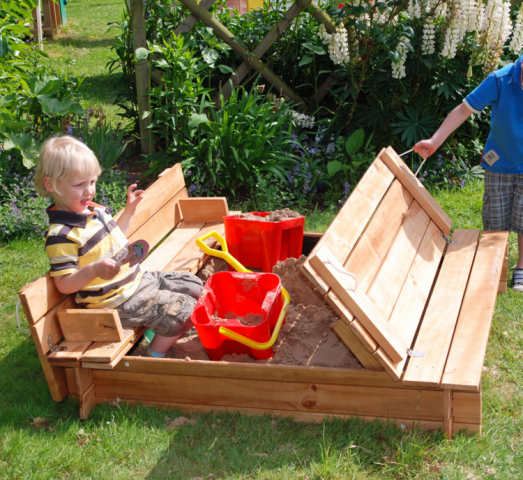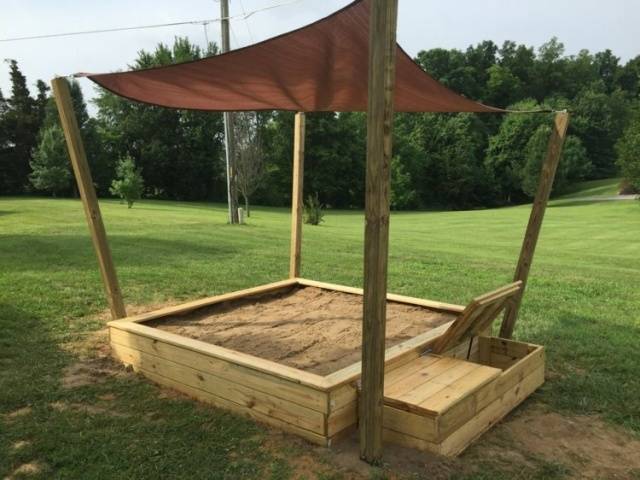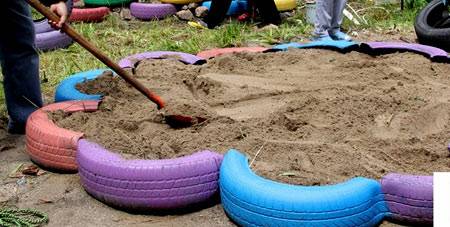Content
When a small child grows up in a family, parents try to arrange a children's corner for him. The best outdoor entertainment is a playground with swings, slides and a sandbox. In cities, such places are set up by appropriate services, but at their summer cottage, parents have to create a children's corner on their own. Now we’ll talk about how to make a children’s sandbox with your own hands, and look at several interesting projects.
Where is the best place to install a sandbox for a child?
Even if a child’s sandbox is installed in the yard, it should not be hidden behind tall plants or buildings. The play area with children should always be in full view of parents. It is optimal to place the sandbox near a large tree so that on a hot summer day its crown protects the playing child from the sun. However, you shouldn’t heavily shade the playing area. On cool days, the sand will not warm up, and the baby may catch a cold.
It is optimal when the constructed sandbox is partially shaded. Such a place can be found in the garden among the trees, but it is usually located out of sight of the parents and is not available at every dacha. In this case, there are few ideas for placement.All that remains is to simply arrange a play area in the sunny part of the yard, and to shade it, make a small canopy in the shape of a fungus.
What materials are best to build a sandbox from?
Store-bought sandboxes for children are made of plastic. This is the best material in this case. The plastic has no burrs and is resistant to aggressive environmental influences. But since you’ve decided to make a children’s sandbox with your own hands, it’s better to choose wood as a building material. The material is easy to process. You can cut out the most beautiful figures of fairy tale characters or animals from the board. The only requirement is good wood processing. All elements of the sandbox are made with rounded corners and well polished to prevent burrs so that the child does not get injured during play.
An alternative to wood is car tires. From tires, there are many ideas for sandboxes, and successful ones. Craftsmen carve birds and animals from tires, and decorate the sandbox itself in the form of a flower or geometric figure.
Among the many ideas, it is worth considering the option of using stone. A sandbox made of cobblestones or decorative bricks turns out beautiful. If desired, you can lay out an entire playground with a castle, sandbox, labyrinths, etc. However, in terms of safety, stone is not the best material due to the possibility of injury to a child. Parents make such structures at their own peril and risk.
Making a wooden sandbox with a lid
Now we will look at a common option, how to make a sandbox with your own hands from wood with a lid. From the very beginning, we will discuss all issues regarding the design scheme, selection of optimal sizes, materials and other nuances.
A wooden sandbox is a rectangular box, and to make it you do not need to develop a complex project or draw drawings. The optimal dimensions of the structure are 1.5x1.5 m. That is, it turns out to be a square box. The sandbox is not very spacious, but there is enough space for three kids to play. If necessary, the compact dimensions of the structure allow it to be moved to another place in the summer cottage.
From the very beginning, you should think about the design of the sandbox. So that the child can relax while playing, it is necessary to build small benches. Since we are making a closed sandbox, in order to save material, the lid should consist of two parts and transform into comfortable benches.
The height of the sides of the box should allow it to accommodate such an amount of sand that the child does not grab the soil with a shovel. But you can’t build a very high fence either. It will be difficult for the baby to climb over it. When determining the optimal dimensions of the board, you can take blanks 12 cm wide. They are knocked down in two rows, getting sides 24 cm high. For a child under five years of age, this will be enough. Sand is poured into the box 15 cm thick, so between it and the bench there is optimal space for comfortable sitting. It is better to take a board thickness within 3 cm. Thinner wood will crack, and thick pieces will result in a heavy structure.
The photo shows a do-it-yourself children's sandbox in finished form. The lid of two halves is laid out on comfortable benches with a back. Let’s look at just such a design and how to create it step by step.
Before we move on to making the box, we need to consider the design of the lid and its purpose. Someone will say that a sandbox can be made without benches, so as not to bother with the lid, but the point is not only about them. You will still have to cover the sand. The lid will prevent the entry of leaves, branches and other debris, and will protect cats from encroachment. Covered sand will always remain dry after morning dew or rain.
Transforming the lid into benches is a good idea to add additional amenities to the playground. In addition, you won’t have to constantly take it to the side and think about where to remove it from under your feet. The structure should open easily and not move out of place. To do this, the lid is made of a thin board 2 cm thick and attached to the box with hinges.
So, we figured out all the nuances. Next, we offer step-by-step instructions for making a sandbox with a lid:
- At the sandbox installation site, the turf layer of earth along with the grass is removed. The resulting depression is filled with sand, compacted and covered with geotextiles. You can use black agrofibre or film, but the latter will have to be holed in places for drainage. The covering material will prevent weeds from growing in the sandbox and will prevent the child from digging into the ground.
- At the corners of the future fence, posts made of timber 5 cm thick are driven into the ground. Since we have decided that the height of the sides will be 24 cm, we take blanks for the posts 45 cm long. Then 21 cm will be driven into the ground, and part of the post will remain on the surface on one level with the sides.
- The boards are cut to lengths of 1.5 m, after which they are carefully sanded so that not a single burr remains. This is not an easy task, so if possible, it is better to use a grinder. The finished boards are screwed in two rows with self-tapping screws to the installed racks.
- Now let's figure out how to build a lid with benches. In our sandbox, its structure is simple, you just need to prepare 12 boards 1.6 m long. Why was this length chosen? Yes, because the width of the box is 1.5 m, and the lid should extend slightly beyond its boundaries. The width of the boards is calculated so that all 12 pieces fit on the box. If the boards are wide, you can take 6 of them. The main thing is that in each half of the hinged lid there are three separate segments.
- So, the first segment of the folding half is screwed with self-tapping screws to the edge of the box. This element is stationary and will not open. The second segment is connected to the first with loops from above. The third segment is connected to the second with loops from below. I screw two bars perpendicularly to the third segment from above. Their length covers the width of the second segment, but the workpieces are not attached to it. The bars in the unfolded bench will play the role of a backrest limiter on the back side. At the bottom of the second segment along its width, two more bars must be secured, which will limit the backrest in front so that it does not fall.
- Exactly the same procedure is performed with the second half of the lid. In the photo you can clearly see the design of the lid with the folded and unfolded half.
When the sandbox is completely finished, you can fill it with sand. We have already talked about the thickness of the layer - 15 cm. Purchased sand is sold clean, but river or quarry sand will have to be sifted and dried yourself.If the sandbox is installed permanently and there are no plans to move it, the approach to the playing area can be paved with paving slabs. The soil around the sandbox is sown with lawn grass. You can plant low-growing small flowers.
Ideas for improving children's sandboxes
Next, we offer you photos and ideas for do-it-yourself children’s sandboxes, which you can use to set up a playground at home. We have already looked at the benches made from the lid, and we will not repeat them. By the way, this option can be taken as a standard for arranging any rectangular sandbox.
You can make an excellent mushroom over the playing area using a large umbrella. They are often used when relaxing on the beach. The umbrella is installed so that it shades the sandbox, but does not interfere with the child’s play. The only drawback of such a canopy is instability in the wind. To ensure the reliability of the structure, a collapsible clamp is provided on one of the sides, which is used to secure the umbrella rod while the child is playing.
Returning again to the hinged lid, it should be noted that the bench can be made from only one half. The second part of the shield is also made folding, but one-piece without segments. The lid is attached with hinges directly to the box. The box itself is divided into two compartments by a jumper. Under the solid lid there is a niche for storing toys or other things. The second compartment with a bench is filled with sand for playing.
If there is space under the steps of the house, it will be possible to organize a good playground here.It may be difficult to install the lid, so the bottom of the sandbox is arranged using a different method. In strong winds and rain, drops of water will fly onto the sand. To prevent dampness on the area under the house, the bottom of the sandbox is covered with crushed stone, then geotextiles are laid, and sand is poured on top. The drainage layer will remove excess moisture, and after rain the playground will quickly dry out.
Covers for the sandbox do not have to be transformed into benches. The box can be divided into two compartments: in one you can make a niche for toys with a hinged lid, and in the other you can organize a sandbox with a roll-up lid.
If you install high posts at the corners of a square sandbox, you can stretch a canopy on top of it from a tarpaulin. Boards are nailed flat along the edges of the sides. These will make benches without a back. Behind a fence made of boards, a chest is knocked down into one or two compartments. The box is suitable for storing toys. On the lid of the chest you can provide limiters that will stop it when open. Then a comfortable backrest will appear on one of the benches.
Have you dreamed of a mobile sandbox? It can be made on wheels. Mom can roll this kind of playground across the hard surface to any place in the yard. Furniture wheels are attached to the corners of the box. Sand and children have an impressive weight, so the bottom of the box is made of boards 25–30 mm thick, with small gaps left between them. They are needed to remove moisture after rain. To prevent sand from spilling into these cracks, the bottom is covered with geotextiles.
The sandbox does not have to be square or rectangular. By installing additional posts around the perimeter of the structure, you will get a hexagonal fence.With a little thought, the box can be made triangular or in the form of another geometric shape.
A cape made of waterproof tarpaulin will help replace the wooden lid on the sandbox. It is especially relevant on structures of complex shape, where it is difficult to make a wooden shield.
A sandbox can be more than just a place for playing with cars or making Easter cakes. A simulated structure in the shape of a ship will take young travelers on a voyage around the world. A sail made of colored material is attached to the opposite sides of the box. It is held on top by a crossbar between two posts. In addition, the sail will provide shading for the playing area.
We have already talked about a mobile sandbox on wheels. Its disadvantage is the lack of a canopy. Why not build it? You just need to secure the timber racks at the corners of the box, and stretch colored fabric or tarpaulin on top. On the sides between the posts you can attach colored flags. On such a ship you can take children for a short ride around the yard.
An alternative to a traditional wooden box is a sandbox made from a large tractor tire. The side flange is cut out of the tire, leaving a small edge near the tread. The edges of the rubber are not sharp, but it is better to cover them with a hose cut lengthwise. The tire itself is painted with multi-colored paints.
Small tires give free rein to your imagination. They are sawn into two or three equal segments, painted in different colors, and then sandboxes of unusual shapes are created. Each tire segment is connected using wire or hardware. There are many options for making sandboxes. The most common form is a flower. It is laid out from five or more halves of tires.Pieces of tires are also used to cover the frame of the complex-shaped sandbox, made of flexible material.
The video shows a version of a children's sandbox:
Conclusion
So, we looked in detail at how to make a children's sandbox and ideas for improving it. The structure you assemble with love will bring joy to the child and peace of mind to the parents.


























